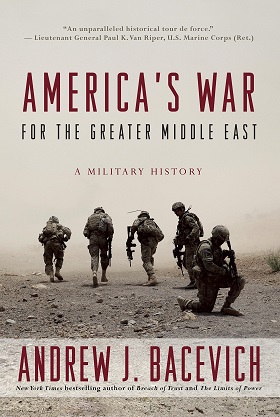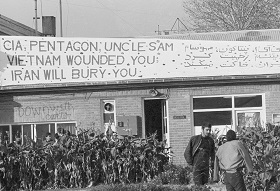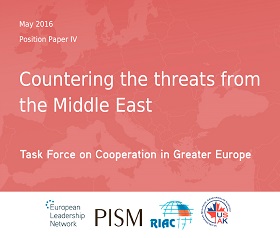The book “America’s War for the Greater Middle East: A Military History” by Andrew Bacevich, a retired colonel and a military historian, represents a detailed account of US overt as well as covert military involvement in the Islamic World. The author goes through 36 years of interventions in the Middle East starting with the revolution in Iran trying to link them to political developments in Washington and find a common theme in them. It is a harsh, yet a necessary look not just at where the United States is in the Middle East today, but at how and by whom its foreign policy is designed.
The book “America’s War for the Greater Middle East: A Military History” by Andrew Bacevich, a retired colonel and a military historian, represents a detailed account of US overt as well as covert military involvement in the Islamic World. The author goes through 36 years of interventions in the Middle East starting with the revolution in Iran trying to link them to political developments in Washington and find a common theme in them. It is a harsh, yet a necessary look not just at where the United States is in the Middle East today, but at how and by whom its foreign policy is designed.
Bacevich opens his book with a thought-provoking idea: “From the end of World War II to 1980, virtually no American soldiers were killed in action while serving in that region. Within a decade, a great shift occurred. Since 1990, virtually no American soldiers have been killed in action anywhere except in the Greater Middle East.” In similar fashion the author confronts conventional beliefs about the US foreign policy as well as questions its logic and goals throughout the book.
The key novelty of Bacevich’s work is analyzing seemingly unconnected campaigns ranging from the failed attempt to rescue American hostages in Iran in 1980 to Mogadishu firefight in 1993 and the Iraq invasion in 2003 as episodes of a single war. This war and its goals have been changing as new Administration came to the White House and as new challenges arose.
According to Andrew Bacevich, America’s war for the Greater Middle East was “a war to preserve the American way of life, rooted in a specific understanding of freedom and requiring an abundance of cheap energy.” In other words for Americans to continue to enjoy the way of life that they have in the last 50 years oil should be easily accessible and come at a low price, this is what Bacevich calls “oil as a prerequisite for freedom.” Clearly it was only a matter of time until oil would become a threat to rather than a facilitator of Americans’ freedom.
The so-called Carter Doctrine features in the book as the key trigger that sparked the American War for the Greater Middle East. Witnessing the economic failures and the second oil shock that were threatening to “undermine” the American way of life, Bacevich argues, made Jimmy Carter deliver his famous malaise speech. In it President Carter called on fellow Americans to abandon their strife for excessive wealth that was poisoning the United States and urged them to re-discover true values. The nation’s unequivocal rejection of Carter’s vision forced him to enter questionable wars in the Middle East (that were not America’s to fight in the first place) to secure the nation’s way of life.
With Carter inaugurating America’s war for the Greater Middle East each subsequent intervention only deepened US involvement in the region. According to Basevich, however, the United States continuously miscalculated its own military capabilities in the region and mistakenly believed that the region was ready to adopt American liberal values as its own. Bacevich brilliantly outlines what makes the US policy in the Middle East so flawed: It is a combination of the “See-what-you-want-to-see-and-ignore-the-rest” approach and the fact that continuously “US policymakers mistook symptom for disease.”
US involvement in the Middle East to a large extent shaped the way its military looks today. Bacevich, a retired Army colonel with over 30 years of military experience, analyzes to what extent modus operandi of the American army was influenced by campaigns in the Islamic world. Here he talks about the evolution of CENTCOM that was established in 1983 and whose Area of Responsibility includes the Middle East. Then during the Gulf War came the notion of RMA (Revolution in Military Affairs) that advocated for US dominance over superior military technologies, and during the wars in Iraq and Afghanistan a counterintelligence (COIN) doctrine came to prominence.
America’s war for the Greater Middle East also allowed its arms manufacturers to become a more powerful political force. “Although some in Congress expressed concern that the United States— far and away the world’s leading weapons exporter— might be fueling a Middle East arms race, most members found little reason to complain about this boon to the American military-industrial complex,” Bacevich argues.
“America’s War for the Greater Middle East” is first and foremost a book about the United States and the inner workings of its political as well as military elites, the Middle East itself plays a supporting role in it. This approach leads to simplification and generalization of local dynamics and factors, making the US solely responsible for any instability. In a similar way, this book presents an account of wars of elites against elites, while almost entirely failing to examine the lives of ordinary people.
Identifying “the Greater Middle East”
It is quite symbolic that Andrew Bacevich chooses the term “the Greater Middle East” coined by the second Bush administration to denote the areas where the US has left a military footprint. Critics argue that this is a mutative term that conveniently served as a justification for the ever expanding geography of American involvement in the region as well as created a pre-text for ongoing operations against Al Qaeda in Pakistan.
What was initially seen as an attempt to secure America’s access to oil resources of the Gulf in the late 70s under Jimmy Carter would spell troubles in Afghanistan through the policy of containment and later transform into the Iraq War through the notion of preventive wars. The snowballing character of these events explains the need for an artificial term like “the Greater Middle East” and while the author criticizes the Administrations that made all the wrong choices in the region he sticks to this flawed term.
Bacevich goes even further and includes in his narration the operations in Bosnia and Kosovo, the two regions that were never considered “the Greater Middle East” even by the George W Bush Administration. Predictably the author himself asks a question as to whether the Balkan wars actually belong in the book. Bacevich’s answer to this question, however, is strictly positive because according to him “to exclude the Balkan campaigns from the narrative of America’s war for the Greater Middle East is to overlook the weaknesses in US military practice destined to afflict the larger-scale military campaigns just ahead.”
Notably it’s the Balkan campaigns where the author’s generalization of Muslim identity becomes apparent. Bacevich argues that “of all the various campaigns comprising that larger enterprise [America’s War for the Greater Middle East], Kosovo and Bosnia alone found US forces fighting on behalf Muslims against a non-Muslim adversary.” To put this into context, to the author, much like to American policy makers throughout the book, Muslims in the Balkans are the same followers of Islam found anywhere between Morocco and Egypt, Turkey and Yemen. This is as misleading as to suggest that Christians in Russia are no different to Christians in Latin America.
Ascribing a single (often simplistic) identity to all Muslims of “the Greater Middle East” is misleading and in policy making is simply dangerous as becomes evident from Basevich’s book. For most of the 80s and the 90s the Cold War template of policy making towards the Islamic World guided the White House and the Pentagon. This, as the author rightly notes, “entailed simply ignoring inconvenient cultural, religious, and sectarian complexities.” Islam rarely featured as a factor worth considering in policy briefs in Washington.
While faith and its projection on local politics is crucial in understanding today’s Greater Middle East, its influence is not even throughout the region that Bacevich explores in his book. Islam plays a minor role in Kosovo politics today, primarily because the country lives under heavy European influence. Iraq’s Saddam Hussein (to whom a significant part of narration is dedicated), on the other hand, was an Arab nationalist for whom religion was a tool to win public support, while Iran lives by strict Islamic principles. In other words reducing the Middle East to a generic understanding of Islam is as wrong as to overly generalize the identity of Muslims, the mistake the author seems to have made on both accounts.
Where does Syria fit in the War for the Greater Middle East?
Andrew Bacevich’s book is especially timely today because it may give a hint as to where the Syrian conflict fits within the narrative of America’s war for the Greater Middle East. According to the author, “after Libya (not to mention Iraq and Afghanistan), it was impossible to sustain the illusion that eliminating this or that unsavory regime held the key to putting the region back together again.” This statement suggests that given the missteps made by the US military in the Middle East the Obama Administration should have stayed out of Syria. The events of the past five years, however, prove that this was not the case. In fact the scenario that the White House opted for in Syria is reminiscent of past campaigns, the ones that have left a poisonous trail in the Middle East.
While Bacevich argues that “reluctant to compound past errors, he [President Obama] resisted— or tried to resist— calls to intervene further in the Syrian civil war,” the facts on the ground disprove this. In Syria, Washington felt compelled to intervene indirectly on behalf of the political opposition and armed rebel groups. There are no immediate benefits for the US to fight for in this conflict but at some point in the American War for the Greater Middle East, as the author rightly points out, “faced with some grave injustice or large-scale violation of human rights, presidents now found it increasingly hard to justify inaction.” In other words the moral obligation to protect the oppressed in the Middle East that the White House voluntarily took upon itself and that Bacevich refers to several times in his book was at play in Syria.
The approach that the Pentagon chose may have allowed the US to avoid putting boots on the ground but is not entirely flawless. The tactic of supplying military aid to Syria’s “moderate rebels” is too reminiscent of the policy towards Afghanistan (which Bacevich discusses at length) when Afghan insurgents were receiving $470mln in military aid from the US annually to fight Soviet troops. The subsequent rise of the Taliban and Al Qaeda is a bitter reminder of the fact that even a proxy war bears dangerous consequences.
With the United States giving “a preference for uniforms over suits” in its Middle Eastern affairs has needlessly complicated the status quo that the world powers are still trying to untangle. Andrew Bacevich argues that the argument that “the United States should rely on soldiers rather than diplomats to secure its interests in the region” is firmly embedded in the country’s vision of the Greater Middle East and this is exactly what makes its long-term strategic goals and its wish for stability there unachievable. The author compellingly concludes that “at the end of the day, whether the United States is able to shape the Greater Middle East will matter less than whether it can reshape itself.”








